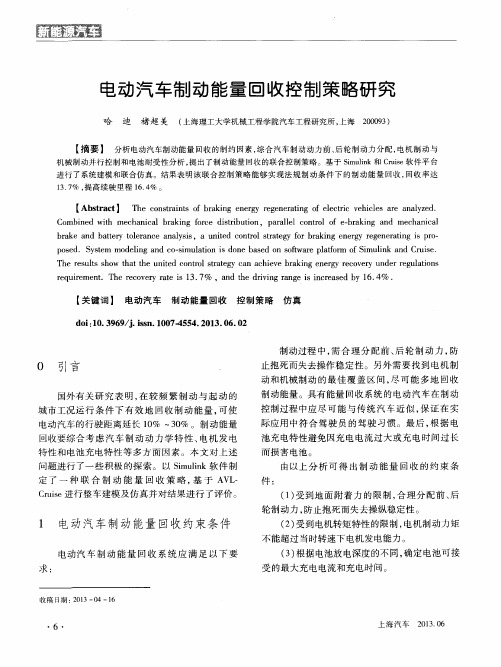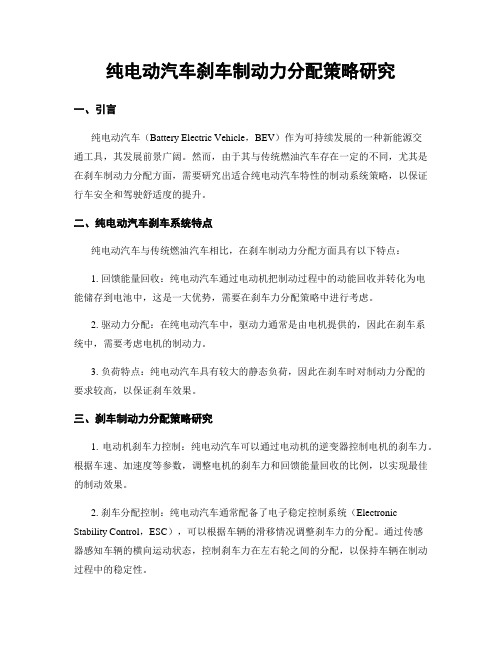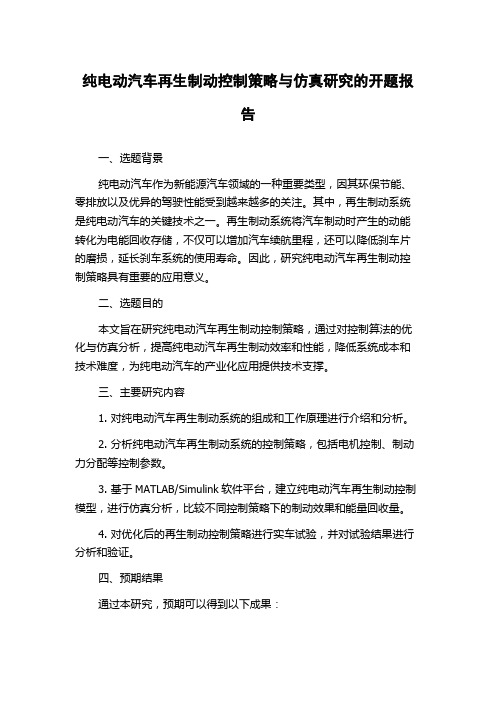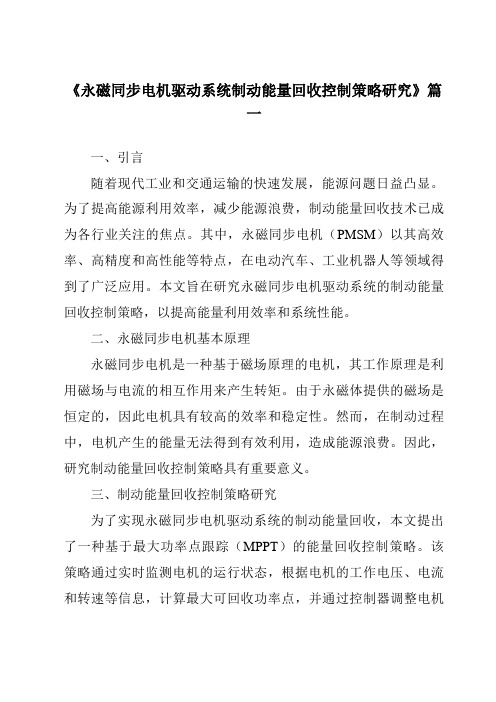纯电动汽车制动能量回收控制策略研究
电动汽车制动能量回收控制策略

机电信息工程电动汽车制动能量回收控制策略徐向明(东风悦达起亚汽车有限公司,江苏盐城224051)摘要:本文深入探讨了制动能量回收控制策略,在此基础上提出了制动能量回收方案并做出相应的仿真分析,为控制系统的再开发和优化提供了充足的理论和实验依据&关键词:电动汽车;制动能量回收;控制策略1制动能量的回收1.1制动模式通常情况下,电动汽车制动模式包括紧急制动、正常制动和下长坡制动。
(1)紧急刹车。
该过程机械摩擦制动占主导地位,电制动发挥辅助作用,制动加速度超过2m/s2。
因为紧急制动使用机会不多,持续时间也不长,所以只能回收利用较少的能量。
(2)正常刹车。
汽车在正常行驶出现的制动有减速和停止2类。
前者依靠电制动,并产生制动能量;后者靠机械摩擦起到制动效果。
电机发电特性决定了制动的切换点,掌握切换点的详细情况才能最大程""""""""""""""""""""""""趋势下,如何实现资源的高效利用或重复利用、废物利用是科学技术发展的重要方向。
2.2现阶段存在的问题现阶段电梯控制技术中存在的问题主要有:第一,电梯的节能问题。
随着电梯的广泛应用,电梯需求量不断攀升,其对能源的消耗也在相应增加,实现能源的高效利用是电梯控制技术发展中主要解决的问题之一。
第二,电梯运行效率。
电梯作为载具,在技术改进的过程中如何确保电梯安全的基础上实现运行效率的提升也是未来电梯控制技术发展的重点。
第三,控制器性价比问题。
当前我国研发的电梯技术核心设备同国外成熟的技术相比具有周期长、成本高的问题,部分电梯企业为提高效率从国外引进技术,价格也较高,电梯设备整体性价比不高。
3电梯控制技术发展方向现阶段各行各业的新技术涌现给电梯控制技术的发展提供了“源泉”,诸如近年来已经得到快速发展的同步和异步电动机、能量回馈技术以及节能群控技术等能满足节能的要求,尤其是能量回馈技术,对于度地将制动能量回收利用。
电动汽车制动能量回收控制策略研究

纯电动汽车刹车制动力分配策略研究

纯电动汽车刹车制动力分配策略研究一、引言纯电动汽车(Battery Electric Vehicle,BEV)作为可持续发展的一种新能源交通工具,其发展前景广阔。
然而,由于其与传统燃油汽车存在一定的不同,尤其是在刹车制动力分配方面,需要研究出适合纯电动汽车特性的制动系统策略,以保证行车安全和驾驶舒适度的提升。
二、纯电动汽车刹车系统特点纯电动汽车与传统燃油汽车相比,在刹车制动力分配方面具有以下特点:1. 回馈能量回收:纯电动汽车通过电动机把制动过程中的动能回收并转化为电能储存到电池中,这是一大优势,需要在刹车力分配策略中进行考虑。
2. 驱动力分配:在纯电动汽车中,驱动力通常是由电机提供的,因此在刹车系统中,需要考虑电机的制动力。
3. 负荷特点:纯电动汽车具有较大的静态负荷,因此在刹车时对制动力分配的要求较高,以保证刹车效果。
三、刹车制动力分配策略研究1. 电动机刹车力控制:纯电动汽车可以通过电动机的逆变器控制电机的刹车力。
根据车速、加速度等参数,调整电机的刹车力和回馈能量回收的比例,以实现最佳的制动效果。
2. 刹车分配控制:纯电动汽车通常配备了电子稳定控制系统(Electronic Stability Control,ESC),可以根据车辆的滑移情况调整刹车力的分配。
通过传感器感知车辆的横向运动状态,控制刹车力在左右轮之间的分配,以保持车辆在制动过程中的稳定性。
3. 制动系统与驱动系统的协同控制:纯电动汽车的驱动系统和刹车系统可以进行协同控制,以提高整车的刹车性能和能量回收效率。
通过电动机控制器和制动系统的信息交互,实现驱动力和制动力的协同分配,既能保证刹车安全,又能最大程度地回收能量。
4. 基于车辆动力学模型的刹车制动力分配策略:通过建立纯电动汽车的动力学模型,考虑车辆的质量、惯性、制动器特性等因素,基于最优化算法确定最佳的刹车力分配策略,以实现制动距离的最小化和驾驶舒适性的提升。
四、刹车制动力分配策略的实验验证和优化1. 实验设备与测试方法:建立实验台架,采用刹车力测量传感器对刹车力进行实时监测,在不同速度和路况下进行刹车测试,以评估刹车力分配策略的性能。
纯电动商用车制动能量回收策略研究

纯电动商用车制动能量回收策略研究传统汽车制动方式是以机械制动或摩擦制动为主。
制动过程会消耗部分动能,并且大部分能量会被转化为热能而散失,造成极大的能量浪费。
电动汽车在进行制动时,可以基于驱动电机的可逆性,及时由驱动状态转换为发电状态。
合理利用制动能量回收,能够将制动过程中产生的能量进行利用,并传输回电池系统,达到良好的能量回收效果。
当前,国内外学者在这方面的研究已经逐步深入,并应用于设计方案中。
本文在简要概述新能源汽车制动能量回收控制策略的基础上,基于能量回收控制基本原理和系统设计原则提出相应的优化策略,以期为相关研究提供参考。
1 新能源汽车制动能量回收控制策略优化的意义在我国新能源汽车行业高速发展的背景下,关于制动能量回收控制方面的研究也越来越丰富。
不少学者从制动力分配策略、电机性能、储能装置性能状态、再生制动系统结构、行驶工况等各个方面,提出了关键技术原理及应用要求[1]。
部分技术已经开始应用于生产中,并取得了良好的应用成效。
但是,由于制动能量回收控制的应用需要综合考虑系统的安全可靠性及成本等因素。
故在实际应用中,还需对能量回收策略作进一步优化,确保回收效果达到最优化水平,加快新能源汽车技术的迅速发展,提升新能源汽车市场竞争力,促进该行业的可持续发展。
2 新能源汽车制动能量回收控制的基本原理2.1 驱动电机特性驱动电机是新能源汽车的核心部件。
在当前技术条件下,汽车厂商应用的驱动电机类型主要有开关磁阻电机、异步电机、永磁同步电机和直流电机等类型。
不同类型电机在功率密度、质量、体积、转速范围、可靠性等参数性能上有着较为明显的差异。
其中,永磁同步电机应用较为广泛,其次是异步电机,其余2种电机类型应用较少[2]。
永磁同步电机运行原理是基于逆变器将电流转变为三相交流电,在流过定子绕组结构时,感应出一定强度的空间磁场。
受磁场作用影响,转子输出电磁转矩并开始旋转,直至达到与旋转磁极转速同步状态。
基于永磁同步电机转速与输出转矩的正向和反向的各自不同状态叠加,车辆可呈现出正常行驶、制动、倒车等运行状态。
纯电动汽车再生制动控制策略与仿真研究的开题报告

纯电动汽车再生制动控制策略与仿真研究的开题报告一、选题背景纯电动汽车作为新能源汽车领域的一种重要类型,因其环保节能、零排放以及优异的驾驶性能受到越来越多的关注。
其中,再生制动系统是纯电动汽车的关键技术之一。
再生制动系统将汽车制动时产生的动能转化为电能回收存储,不仅可以增加汽车续航里程,还可以降低刹车片的磨损,延长刹车系统的使用寿命。
因此,研究纯电动汽车再生制动控制策略具有重要的应用意义。
二、选题目的本文旨在研究纯电动汽车再生制动控制策略,通过对控制算法的优化与仿真分析,提高纯电动汽车再生制动效率和性能,降低系统成本和技术难度,为纯电动汽车的产业化应用提供技术支撑。
三、主要研究内容1. 对纯电动汽车再生制动系统的组成和工作原理进行介绍和分析。
2. 分析纯电动汽车再生制动系统的控制策略,包括电机控制、制动力分配等控制参数。
3. 基于MATLAB/Simulink软件平台,建立纯电动汽车再生制动控制模型,进行仿真分析,比较不同控制策略下的制动效果和能量回收量。
4. 对优化后的再生制动控制策略进行实车试验,并对试验结果进行分析和验证。
四、预期结果通过本研究,预期可以得到以下成果:1. 详细分析纯电动汽车再生制动系统的组成和工作原理,深入了解再生制动技术的原理;2. 研究纯电动汽车再生制动系统的控制策略,找出不同控制策略的优缺点;3. 基于MATLAB/Simulink软件平台,建立纯电动汽车再生制动控制模型,进行仿真分析;4. 对优化后的再生制动控制策略进行实车试验,验证仿真结果的可靠性。
五、论文结构1.绪论1.1 选题背景和意义1.2 国内外研究现状和进展1.3 本论文研究内容和方法1.4 论文组织结构2.纯电动汽车再生制动技术分析2.1 再生制动技术原理2.2 再生制动系统组成和控制策略3.纯电动汽车再生制动控制系统建立3.1 纯电动汽车控制系统概述3.2 再生制动控制系统建立3.3 电机控制策略研究4.纯电动汽车再生制动控制仿真分析4.1 仿真模型建立和参数设计4.2 不同控制策略下的仿真分析4.3 仿真结果分析5.纯电动汽车再生制动实车试验5.1 试车平台建立和实验设计5.2 试车数据采集和分析5.3 试车结果分析6.总结与展望6.1 研究成果总结6.2 研究存在问题和改进方向6.3 纯电动汽车再生制动未来发展趋势参考文献。
纯电动汽车制动能量回收策略

纯电动汽车制动能量回收策略摘要:纯电动汽车作为一种解决能源短缺问题和环境污染问题的一项主要技术,其续航能力的不足严重影响了发展和实际应用,而制动能量回收技术作为解决纯电动汽车续航不足问题的最为有力策略,近年来得到了学术界的广泛关注。
基于此,本文在对制动能力回收基本进行简要介绍的基础上,提出了一种基于 ECE R13 法规要求的定比并联制动控制策略,并进行了仿真。
最后,希望本文的研究能够具备一定的借鉴价值。
关键词:纯电动汽车 ECE R13 再生制动控制策略当前汽车已经成为人们日常出行的必备交通工具,然而传统汽车的普及也进一步加速了石油资源的消耗,从而带来了较为严重的环境污染问题。
相关数据研究表明:2017年我国汽车销售量为3012.84万辆,同比增长18.36%,环比增长9.43个百分点[1]。
因此,为了实现我国经济的可持续发展,以节能、环保为特点的电动汽车将会成为未来研究的重点领域。
电动汽车作为一种零排放的交通工具,不但能够替代传统的内燃汽车可以有效解决环境污染的问题,而且还能够节能减排,极大程度的来减缓全球所面临的能源危机问题。
那么,对于电动汽车来讲,其研究的重点为则为能量储备技术的改进以及储备利用率的提升问题,解决能量储备问题的关键点在电池方面,但是从当前的技术现状来看,蓄电池能力存储技术不会在较短的时间内实现大的突破,那么如何提高能量利用率就成为了电动汽车产业化发展过程的重中之重。
所谓提高能力利用率其实就是指提高电池的使用期限,即电池管理系统。
本文所研究的重点则是电池管理系统中一项非常重要的问题,即电动汽车制动能量的回收控制策略[2]。
1制动能量回收基本原理制动能量回收也被称为再生制动,主主要内涵是指电机在发电状态下,将动能转化为电能后进行储存,为汽车的制动系统提供能量,这样就能够实现能能量的循环利用[3]。
对于纯电动汽车来讲,其制动能能量的回收系统如图1.1所示:图1.1纯电动汽车制动能能量回收系统示意图从上图可以看出,纯电动汽车制动能量回收系统主要由整车控电池组、能量管理系统、整车控制器、变换器、电机控制单元等部分组成[4]。
纯电动汽车制动能量回收控制策略及仿真分析

NEW ENERGY AUTOMOBILE | 新能源汽车时代汽车 纯电动汽车制动能量回收控制策略及仿真分析王若飞 郭广曾 王世良浙江合众新能源汽车有限公司 浙江省桐乡市 314500摘 要: 整车控制系统是车辆的核心控制部分,其既要对驾驶员的操纵意图进行识别和判断,又要对整车运行时的关键参数进行监测和控制,同时,还要对整车的能量需求进行管理和协调。
在车辆制动工况下,如果进行制动能量的回收控制,可以有效的延长续驶里程,但电动汽车在进行回馈制动时,电制动会和机械制动系统相互耦合,这一问题解决的好坏,也会影响到车辆行使的安全性。
本文阐述了对制动模式下机械制与电机再生制动的协调开展研究,目标是进一步保证车辆行驶的安全性和舒适性,提高制动时的能量回收效率。
关键词:整车控制器 能量回收 仿真1 研究方案及研究方法本位重点对再生制动时的控制策略进行研究。
分别对这两个研究内容进行模型分析,设计控制策略,利用仿真分析软件,对所设计的策略进行仿真分析和验证。
具体方法如下:1)建立研究对象制动时的纵向动力学数学模型,设计再生制动力分配的模糊控制器;2)在matlab软件中,应用粒子群算法,对模糊控制器的模糊规则进行优化;3)对优化后的模糊控制器,设计不同的制动工况,进行离线仿真验证;4)写控制代码,下载到控制器的工程样机中,在硬件在环仿真平台上,对控制算法进行半实物仿真验证。
2 研究过程及研究结果2.1 再生制动控制策略设计再生制动控制的原则是保证汽车制动稳定性的同时,综合考虑能量回收效率。
针对前轮驱动电动车辆,液压控制单元(ABS)采集到的制动踏板位置、轮速等信息,通过车载网络传递给整车控制器(VCU),VCU根据接收到的信息,结合动力电池组、驱动电机的状态信息,计算出前轮的制动回收扭矩,通过车载网络发送到电机控制器(此时没有考虑驱动扭矩安全监控模块)。
但电动汽车在进行再生制动时,会和车辆的机械制动系统相互耦合,为解决这一机电耦合问题,设计了再生制动扭矩模糊控制器,该控制器的输入量为制动踏板深度,电池荷电状态(SOC),车速三个参数,输出量为电机制动的参与程度,即电机制动力矩占最大可用电机制动力矩的比例,推理方法选用Mamdani推理。
纯电动汽车制动能量回收策略

纯电动汽车制动能量回收策略纯电动汽车制动能量回收策略是指在电动汽车行驶过程中利用制动时产生的能量,通过一系列技术手段将其转化为电能,从而实现能量的再利用,提高整车的能源利用效率。
下面将从三个方面介绍纯电动汽车制动能量回收的策略。
首先是换挡制动能量回收策略。
换挡制动是指在日常驾驶过程中通过换挡档位实现制动的方式。
纯电动汽车采用了单速变速系统,无法实现传统汽车中的换挡制动。
为了解决这个问题,纯电动汽车采用了电动机的反转工作模式,即将电动机从驱动模式切换到发动机制动模式。
当驾驶员踩下制动踏板时,电动机开始反转运行,将汽车的动能转化为电能,并通过逆变器转化为电池能量进行储存。
其次是滑行制动能量回收策略。
滑行制动是指在驾驶过程中松开油门减速,不踩制动踏板的操作方式。
在滑行过程中,电动汽车的电机处于关闭状态,利用惯性滑行减速。
电机的关闭状态下,其转子会处于自由运动状态,此时电机可以作为发电机工作,将汽车的动能转化为电能,并通过逆变器转化为电池能量进行储存。
这种制动能量回收策略,可以在不需要进行急剧减速的情况下,实现能量回收,提高整车的能源利用效率。
最后是制动能量回收系统的优化策略。
制动能量回收系统主要由逆变器和电池组成,为了提高制动能量的回收效率,可以通过优化逆变器和电池的参数配置,使得能量的转化过程更加高效。
例如,合理选择逆变器的工作模式,调整逆变器的输出电流与电压,选用高能量密度的电池材料等,都可以提高制动能量回收的效果。
除了以上策略,还可以通过智能控制系统对制动能量的回收进行优化。
这个智能控制系统可以根据车速、转向、制动力等多种参数进行实时监测和控制,通过根据不同驾驶情况的需求,实现自适应的能量回收策略。
例如,在高速行驶时,可以降低制动强度,减小能量回收的损耗;在低速行驶时,可以提高制动强度,增大能量回收的效果。
综上所述,纯电动汽车制动能量回收策略是通过换挡制动、滑行制动、制动能量回收系统的优化以及智能控制系统的应用等多种手段,实现对制动能量的回收和再利用,提高整车的能源利用效率。
纯电动汽车制动能量回收控制策略研究与仿真

[ 关键词 ] 电动汽车 ; 制动能量回收 ; 控制策略 [ 中图分类号 ]U 4 6 9 . 7 2 [ 文献标志码 ] A [ 文章编 号]1 6 7 3 — 3 1 4 2 ( 2 0 1 3 ) 0 9 — 0 0 3 1 — 0 4
S t u d y a n d S i mu l a i t o n o n Br a k i n g En e r g y Re c o v e r y Co n t r o l S t r a t e g 为有效地 回收 电动汽车的制动能量 , 分析 了再生制动 力的约束条件和电机再生制动力矩 的最大限值 ; 根
据 电机可提供再生制动 力矩与需求的制动 力矩的关 系。提 出了满足 四轮驱动 电动 汽车的制动能量 回收优化控 制策略 , 利 用 Ma t l a b / S i m u l i n k和 A d v i s o r 软件平 台进 行 了系统 建模和典型循环工况下的仿 真, 仿 真结果表 明, 该 控制策略 能够 实现安全条件 下的制动能量 回收. 制动能量回收效率达到 2 2 . 1 1 %。
A d v i s o r . S i mu l a t i o n o f t y p i c l a d i r v i n g c y c l e s i s c o n d u c t e d a n d t h e s i mu l a t i o n r e s u l t s s h o w t h a t t h e j o i n t c o n t r o l s t r a t e y g C n a
mo t o r r e g e n e r a t i v e b r a k i n g t o r q u e l i mi t v a l u e a r e a n ly a z e d .Ac c o r d i n g t o t h e r e l a t i o n s h i p b e t we e n b r a k i n g t o qu e p r o v i d e d b y
新能源汽车制动能量回收系统的研究与应用

新能源汽车制动能量回收系统的研究与应用
新能源汽车在当今社会正变得越来越受欢迎,而制动能量回收技术作为其重要的创新之一,大大提升了新能源汽车的能效。
让我们一起深入探讨新能源汽车制动能量回收系统的研究与应用。
制动能量回收系统是什么?
所谓制动能量回收系统,简单来说就是利用汽车制动时释放的能量,通过特定的装置将其转换为电能进行存储和再利用。
传统汽车在制动时,制动过程中产生的动能会转化为热能散失到空气中,而新能源汽车制动能量回收系统则将这部分能量收集起来,重新利用。
工作原理及关键技术
制动能量回收系统的工作原理主要是通过电动机将制动时产生的动能转换为电能储存到电池中,待需要时再释放给电动机来辅助汽车运行。
关键技术包括制动能量的捕捉、电能的存储和管理、以及能量再利用的控制系统等。
应用现状与优势
目前,越来越多的新能源汽车品牌开始广泛应用制动能量回收系统,例如特斯拉、日产等知名品牌。
制动能量回收系统的应用为新能源汽车带来了诸多优势,包括提升了能源利用率、降低了能耗排放、延长了电池寿命等。
未来发展趋势
随着新能源汽车市场的持续增长,制动能量回收技术也将不断完善与发展。
未来,该技术有望在更多汽车型号上得到应用,进一步提升新能源汽车的性能和竞争力。
新能源汽车制动能量回收系统的研究与应用,不仅提升了汽车的能效和环保性能,也为汽车行业的创新发展带来了新的机遇和挑战。
随着技术的不断进步,相信制动能量回收系统将在未来发挥更加重要的作用,助力新能源汽车行业迈向更加绿色、可持续的未来。
电动汽车行业的制动能量回收技术研究

电动汽车行业的制动能量回收技术研究随着对环境保护和能源消耗的关注不断提高,电动汽车作为一种环保、节能的代表,受到越来越多人的青睐。
然而,目前电动汽车市场发展仍面临着制动能量浪费的问题,而制动能量回收技术的研究和应用则成为了电动汽车行业的热点问题。
在此背景下,本文将全面梳理当前电动汽车行业制动能量回收技术的研究现状及未来发展方向。
一、制动能量回收技术的研究现状随着电动汽车市场的不断扩大,制动能量回收技术成为了电动汽车行业研究的重点。
制动能量回收技术是指利用电动汽车制动时产生的能量,通过技术手段实现回收和存储,再次利用这部分能量来推动车辆行驶。
目前主要的制动能量回收技术包括以下几种:1、光伏制动能量回收技术。
该技术是指在电动汽车制动时,利用光电效应产生的电能来回收制动能量。
可以通过在车载中安装太阳能电池板或在车辆制动部位采用光伏材料来实现。
2、超级电容器回收技术。
超级电容器可以通过高效的储能和放电,使制动时产生的能量迅速回收并存储在电容器中。
同时,该技术还能提高电动汽车的系统效率和充电效率。
3、升压回收技术。
这种技术使用变压器来提高电动汽车制动时发生的低电压,从而将制动能量存储起来。
此外,还可以使用变频器来将直流电转换为交流电,提高能量的存储效果和使用效率。
二、制动能量回收技术的未来发展方向1、加强多种制动能量回收技术的综合应用电动汽车制动时产生的能量可通过多种技术手段回收并存储,加强不同技术之间的协调和配合,可以更加有效地利用每一份能量。
因此,未来电动汽车制动能量回收技术的发展方向可能是以多种技术为基础,互相补充和促进,以进一步提高能量回收效率。
2、开发更高效、可靠的储能技术当前,超级电容器、动力电池等常用的储能装置存在诸多问题。
例如,超级电容器的能量密度低,存储能量有限;动力电池的易损性高,使用寿命较短等。
因此,未来制动能量回收技术的发展方向可能是研发更高效、可靠的储能技术,以提高制动能量的回收效果和使用寿命。
基于模糊控制的纯电汽车再生制动控制策略研究

基于模糊控制的纯电汽车再生制动控制策略研究一、引言纯电汽车作为一种环保、节能的交通工具,在近年来得到了广泛的关注和应用。
为了提高纯电汽车的能量利用效率,再生制动系统被广泛应用于纯电汽车中。
然而,在实际驾驶过程中,由于路况的复杂性和驾驶员驾驶习惯的不同,再生制动控制策略的设计变得至关重要。
本文将以基于模糊控制的方法来研究纯电汽车再生制动控制策略,旨在提高纯电汽车的能量回收效率和驾驶舒适性。
二、纯电汽车再生制动原理再生制动是指利用电动汽车的电机作为发电机,将制动过程中产生的动能转化为电能储存到电池中。
纯电汽车再生制动的基本原理是将车辆的动能通过逆变器转化为电能,再通过电池储存,最后使用储存的电能来驱动电机。
三、模糊控制理论简介模糊控制理论是一种基于模糊逻辑的控制方法。
与传统的精确控制方法不同,模糊控制方法能够更好地处理不确定性和模糊性的问题。
它通过建立模糊规则、设计模糊推理机制来实现对系统的控制。
在纯电汽车再生制动控制中,模糊控制方法可以通过考虑诸多因素,如车速、制动力需求、电池充电状态等,来确定适当的再生制动力。
四、基于模糊控制的纯电汽车再生制动控制模型1. 输入变量的选择在本研究中,我们选择了以下输入变量作为模糊控制的输入:- 车速:用于反映车辆的行驶速度,它直接影响再生制动力的大小。
- 制动力需求:用于表示驾驶员对制动力的需求大小。
- 电池充电状态:用于反映电池的充电情况,进而影响再生制动力输出。
2. 输出变量的选择在本研究中,我们选择了再生制动力作为模糊控制的输出变量,通过控制再生制动力的大小来实现对纯电汽车制动性能的调节。
3. 模糊控制规则的设计通过观察和分析纯电汽车制动过程中的实际数据,我们可以建立一套模糊控制规则。
例如,当车速较高、制动力需求较大、电池充电状态较低时,我们可以通过模糊控制规则来输出较大的再生制动力,以提高制动效果和能量回收效率。
五、实验结果及分析我们运用基于模糊控制的纯电汽车再生制动控制策略进行了一系列实验,并与传统的固定再生制动力控制方法进行了比较。
《永磁同步电机驱动系统制动能量回收控制策略研究》范文

《永磁同步电机驱动系统制动能量回收控制策略研究》篇一一、引言随着现代工业和交通运输的快速发展,能源问题日益凸显。
为了提高能源利用效率,减少能源浪费,制动能量回收技术已成为各行业关注的焦点。
其中,永磁同步电机(PMSM)以其高效率、高精度和高性能等特点,在电动汽车、工业机器人等领域得到了广泛应用。
本文旨在研究永磁同步电机驱动系统的制动能量回收控制策略,以提高能量利用效率和系统性能。
二、永磁同步电机基本原理永磁同步电机是一种基于磁场原理的电机,其工作原理是利用磁场与电流的相互作用来产生转矩。
由于永磁体提供的磁场是恒定的,因此电机具有较高的效率和稳定性。
然而,在制动过程中,电机产生的能量无法得到有效利用,造成能源浪费。
因此,研究制动能量回收控制策略具有重要意义。
三、制动能量回收控制策略研究为了实现永磁同步电机驱动系统的制动能量回收,本文提出了一种基于最大功率点跟踪(MPPT)的能量回收控制策略。
该策略通过实时监测电机的运行状态,根据电机的工作电压、电流和转速等信息,计算最大可回收功率点,并通过控制器调整电机的运行状态,使系统在最佳状态下运行,从而实现能量的最大化回收。
四、控制策略实现方法1. 传感器技术:通过安装传感器实时监测电机的运行状态,包括工作电压、电流和转速等信息。
2. 控制器设计:设计一个高性能的控制器,根据传感器提供的信息实时计算最大可回收功率点。
3. 电机驱动:根据控制器的指令,调整电机的运行状态,使系统在最佳状态下运行。
4. 能量回馈:将回收的能量存储在电池等储能设备中,供系统其他部分使用。
五、实验结果与分析通过实验验证了本文提出的永磁同步电机驱动系统制动能量回收控制策略的有效性。
实验结果表明,该策略能够有效地提高能量的回收率和使用效率,降低系统的能耗。
同时,该策略还具有较高的稳定性和可靠性,能够适应不同的工作环境和工况。
六、结论本文研究了永磁同步电机驱动系统的制动能量回收控制策略,提出了一种基于MPPT的能量回收控制策略。
电动汽车系统能量回收的控制策略

电动汽车系统能量回收的控制策略
1.制动能量回收:制动能量回收是一种常见的能量回收方法,它通过
将制动过程中产生的能量转化为电能,然后存储在电池中供车辆使用。
这
种方法可以显著减少制动能量的浪费,提高车辆的能源利用效率。
制动能
量回收通常使用动力学制动系统或再生制动系统实现。
2.惯性滑行:惯性滑行是一种在滑行状态下尽量减少能量损失的策略。
在惯性滑行状态下,电动汽车可以通过减少电机功率输出或者关闭电机来
减少能量消耗。
这种策略可以在行驶过程中最大限度地回收动能,提高整
车的能源利用效率。
3.能源管理系统:能源管理系统是一种通过优化车辆的系统操作来减
少能量损失的方法。
该系统可以监测和控制电池和电动机的能量流动,以
实现最佳的能源利用效率。
能源管理系统通常使用先进的控制算法来优化
电力分配和能量回收,以最大限度地减少能量损失。
5.能量回收优先级控制:能量回收优先级控制是一种通过优化能量回
收顺序来最大限度地提高能源利用效率的方法。
该策略根据不同的驾驶条
件和车辆需求,优先考虑回收能量最多的系统,以实现能量的最大回收和
利用。
总结起来,电动汽车系统能量回收的控制策略包括制动能量回收、惯
性滑行、能源管理系统、协同驱动系统和能量回收优先级控制等。
这些策
略可以有效地提高电动汽车的能源利用效率,减少能量的浪费,并为车辆
提供更长的续航里程。
未来随着技术的进一步发展,电动汽车能量回收的
控制策略将会越来越成熟和多样化。
纯电动汽车再生制动控制策略研究

再生制动系统工作原理
在制动过程中,电机控制器接收到制动信号后,控制电 机进入发电模式。此时,电机的转子受到车辆惯性的作 用继续旋转,切割定子绕组中的磁感线产生感应电动势 ,从而将车辆的动能转化为电能。这部分电能通过功率 变换器回馈给电池,实现能量的回收。同时,制动控制 器根据制动需求分配制动力,协调再生制动与机械制动 ,确保制动效果和安全。
纯电动汽车以其零排放、低噪音、高效率等 优点受到广泛关注。
再生制动技术是纯电动汽车的关键技术之一 ,能够提高能量利用率和续航里程。
04
研究纯电动汽车再生制动控制策略对于推动 新能源汽车发展具有重要意义。
国内外研究现状及发展趋势
国内外研究现状
目前,国内外学者在纯电动汽车再生制动控制策略方面已经取得了一定的研究成 果,包括基于规则的控制策略、基于优化的控制策略、基于学习的控制策略等。
基于试验设计的参数优化
通过设计合理的试验方案,获取控制策略关键参数对制动 性能、能量回收等目标的影响规律,进而确定参数优化方 向。
灵敏度分析
对控制策略中的关键参数进行灵敏度分析,识别出对制动 性能和能量回收影响显著的参数,为参数优化提供依据。
参数自适应调整
根据车辆实际运行工况和驾驶员操作习惯,实现控制策略 参数的在线自适应调整,提高制动性能和能量回收效率。
基于人工智能技术的控制策略优化
深度学习在控制策略中的应用
利用深度学习技术强大的特征提取和学习能力,构建基于神经网络的再生制动控制策略 模型,实现制动性能和能量回收效率的提升。
强化学习在控制策略中的应用
通过强化学习算法与车辆动力学模型的结合,实现在线学习和自适应调整控制策略参数 ,提高制动性能和能量回收效率。
纯电动汽车再生制动控制策略研究

纯电动汽车再生制动控制策略研究引言纯电动汽车再生制动是一项关键技术,它通过电动机将动能转化为电能并存储在电池中,从而提高能源利用效率。
本文旨在深入探讨纯电动汽车再生制动控制策略的研究,从而实现对动能的高效回收。
能量回收原理纯电动汽车再生制动利用电动机的可逆性,将制动过程中的动能转化为电能。
当驾驶员踩下制动踏板时,电动机被切换为发电机工作模式,并将动能通过电流反馈到电池中。
这种能量回收的方式不仅减少了刹车能耗,还延长了纯电动汽车的续航里程。
电池充电管理策略纯电动汽车再生制动控制策略的核心是电池充电管理。
对于充电管理,可以采用以下策略:1. 先进先出(FIFO)策略FIFO策略将先回收的电能优先存储在电池中,确保较早回收的能量被尽快利用。
这种策略简单且易于实现,但可能导致电池容量不均衡。
2. 能量优先策略能量优先策略将回收的能量优先分配到电池中,以确保电池始终处于最佳充电状态。
这种策略可以最大限度地提高能源利用效率,但需要对电池进行动态管理。
3. 混合策略混合策略综合考虑了FIFO策略和能量优先策略的优点,根据电池当前状态和充电需求来决定能量的分配方式。
这种策略可以在保持电池均衡的同时,提高能源回收效率。
制动能量回收率优化为了最大化制动能量回收率,需要对纯电动汽车的再生制动控制策略进行优化。
以下是几种常见的优化方法:1. 刹车扭矩控制通过调整刹车扭矩,可以控制纯电动汽车的再生制动力度。
合理选择刹车扭矩可以使汽车在制动过程中尽可能回收更多的能量。
2. 能量回收判定算法设计和优化能量回收判定算法是制动能量回收的关键。
该算法根据车辆的制动情况和电池的充电状态,判断何时开始回收能量、何时停止回收能量,以最大程度地提高能量回收率。
3. 制动力分配策略制动力分配策略可以根据车辆当前的制动需求和动力需求来调整制动力的分配比例。
这种策略可以保证制动的稳定性和安全性,并同时实现能量回收的最大化。
实验验证与应用展望为了验证纯电动汽车再生制动控制策略的有效性,需进行实验验证。
纯电动汽车制动器动力回收系统研究

纯电动汽车制动器动力回收系统研究一、引言纯电动汽车作为新能源汽车的重要组成部分,受到越来越多的关注和青睐。
然而,纯电动汽车目前仍然面临续航里程短、充电时间长等问题。
因此,开发高效的动力回收系统成为提高纯电动汽车续航里程和性能的关键。
本文旨在研究纯电动汽车制动器动力回收系统的原理、技术和应用,以期为纯电动汽车的推广和发展提供参考。
二、制动器动力回收系统的原理制动器动力回收系统是指通过汽车制动器将动能转化为电能回收储存在电池中,从而减少能量浪费的系统。
其工作原理基于电机的运转方式,主要包括两种技术:零电压转换技术和零电流转换技术。
零电压转换技术利用电动汽车电机的逆变特性和输出阻尼特性,将动能以电压形式回收,实现能量的高效利用。
零电流转换技术则通过制动器的控制电路,在制动过程中调节电流,实现能量的回收。
三、制动器动力回收系统的技术发展1. 制动力回收系统制动力回收系统是将纯电动汽车制动器与电动机和电池相连接,通过对制动过程中产生的动能进行回收并储存,以满足汽车动力需求。
制动过程中,电动汽车的动能通过制动器将车轮转动的动能转化为电能,然后存储在电池中。
制动力回收系统不仅可以提高纯电动汽车的能源利用效率,还可以延长电池的使用寿命。
2. 制动力回收控制策略制动力回收系统的控制策略对于能量回收的效果有重要影响。
采用适当的制动力回收控制策略可以提高能量回收率,并在一定程度上提高了驾驶安全性。
常见的制动力回收控制策略包括蓄能器制动力回收、压电制动力回收和电机制动力回收等。
3. 制动器能量回收技术制动器能量回收技术是指通过对制动器的改进,提高其能量回收效率的技术手段。
目前,主要有压电材料制动系统、电压积分器制动系统和高性能液压制动系统等。
这些技术的研究和应用可以提高纯电动汽车制动能量的回收效率,进一步改善纯电动汽车的续航里程和驾驶体验。
四、制动器动力回收系统的应用1. 提高纯电动汽车的续航里程制动器动力回收系统可以实现对制动能量的回收和利用,通过将能量储存在电池中,提高纯电动汽车的续航里程。
制动能量回收

电动汽车制动能量回收控制策略的研究摘要:电动汽车的驱动电机运行在再生发电状态时,既可以提供制动力,又可以给电池充电回收车体动能,从而延长电动车续驶里程。
对制动模式进行了分类,并详细探讨了中轻度刹车时制动能量回收的机制和影响因素。
提出了制动能量回收的最优控制策略,给出了仿真模型及结果,最后基于仿真模型及XL型纯电动车对控制算法的效果进行了评价。
关键词:制动能量回收电动汽车镍氢电池 Simulink模型电动汽车(EV)的研究是在环境保护问题及能源问题日益受到关注的情况下兴起的。
在EV性能提高并逐步迈向产业化的过程中,提高能量的储备与利用率是迫切需要解决的两个问题。
尽管蓄电池技术有了长足进步,但由于受安全性、经济性等因素的制约,近期不会有大的突破。
因此如何提高EV能量利用率是一个非常关键的问题。
制动能量回收问题对于提高EV的能量利用率具有重要意义。
电动汽车采用电制动时,驱动电机运行在发电状态,将汽车的部分动能回馈给蓄电池以对其充电,对延长电动汽车的行驶距离是至关重要的。
国外有关研究表明,在存在较频繁的制动与起动的城市工况运行条件下,有效地回收制动能量,可使电动汽车的行驶距离延长百分之十到百分之三十。
目前国内关于制动能量回收的研究还处在初级阶段。
制动能量回收要综合考虑汽车动力学特性、电机发电特性、电池安全保证与充电特性等多方面的问题。
研制一种既具有实际效用、又符合司机操作习惯的系统是有一定难度的。
本文对上述问题作了一些积极的探索,并得出了一些有益的结论。
1制动模式电动汽车制动可分为以下三种模式,对不同情况应采用不同的控制策略。
1.1急刹车急刹车对应于制动加速度大于2m/s2的过程。
出于安全性方面的考虑,急刹车应以机械为主,电刹车同时作用。
在急刹车时,可根据初始速度的不同,由车上ABS控制提供相应的机械制动力。
1.2中轻度刹车中轻度刹车对应于汽车在正常工况下的制动过程,可分为减速过程与停止过程。
电刹车负责减速过程,停止过程由机械刹车完成。
纯电动轿车制动能量回收系统研究

纯电动轿车制动能量回收系统研究摘要:目前国内对于电动汽车回收制动能量的技术还处于初级研究阶段。
具备能量回收的电动汽车上的制动系统,要求在最大限度回收制动能量的同时还得保证汽车良好的制动性能。
因此,需要综合考虑汽车动力学特性/电机发电特性和蓄电池安全充电等多方面的问题,研制一种具有实际效用的制动系统具有一定的难度。
本文主要对纯电动轿车制动能量回收系统进行了分析研究。
关键词:纯电动汽车;制动能量回收;测试一、制动能量回收系统的结构及原理电动汽车的制动能量回收系统是将制动时的动能转换成电能回馈给电池充电,使得能量能够被再生利用,该功能是由驱动电机的控制电路实现的。
因此,电动汽车上的制动系统是再生-液压混合制动系统,本文以此为例介绍混合制动系统的结构和原理。
如图 1 所示。
图 1 是典型的再生-液压混合制动系统,此系统中将前轮的制动能量进行回收,电机产生的再生制动力与传统制动系统产生的摩擦制动力共同作用实现对前轮的制动。
再生制动力和传统制动系统产生的液压制动力的大小是由制动控制器与电机控制器协同工作确定的。
制动能量由再生制动控制模块回收并回馈给电池,电动汽车仍装有 ABS,其作用与传统燃油车上的相同。
图 1. 再生-液压混合制动系统的结构再生制动系统的基本原理是通过电机驱动的自感电动式/反电动势将存储在电枢中的磁场能量以及车体的动能保存至蓄电池中。
二、制动能量回收的影响因素分析影响制动能量回收的因素有以下四个方面:(1)电机的制动能力与可回收的能量多少有重要关系。
电机的制动能力越强,可以回收的制动能量就越多,续驶里程提高的就越多。
电机的外特性决定了电机在当前转速下可输出的最大再生制动比例,如图 2 所示,电机在转速较高时处于恒功率发电状态,转速较低时处于恒转矩发电状态;其次电机的发电能力直接制约再生能量的多少。
图 2. 再生制动时电动机外特性(2)能否对制动能量进行回收及回收的多少取决于电池的荷电状态 SOC 值和温度,若制动过程中电池的 SOC 值很高(例如 0.85 以上),或温度过高(高于 55℃),不能进行制动能量的回收或减小充电电流以保护电池及延长电池的使用寿命。
- 1、下载文档前请自行甄别文档内容的完整性,平台不提供额外的编辑、内容补充、找答案等附加服务。
- 2、"仅部分预览"的文档,不可在线预览部分如存在完整性等问题,可反馈申请退款(可完整预览的文档不适用该条件!)。
- 3、如文档侵犯您的权益,请联系客服反馈,我们会尽快为您处理(人工客服工作时间:9:00-18:30)。
纯电动汽车制动能量回收控制策略探究摘要:随着环保与新能源汽车的飞速进步,电动汽车越来越成为大众消费新的选择。
然而,纯电动汽车在行驶过程中需要通过刹车来减速,而传统刹车方式会浪费大量能量,严峻影响汽车的续航里程。
因此,如何有效地利用制动时产生的能量回收,成为其中一个亟待解决的问题。
本论文主要探究纯电动汽车制动能量回收控制策略,通过对纯电动汽车运动规律和能量消耗的分析,提出了一种基于车辆运动状态的制动能量回收控制策略。
该控制策略可以在不干扰驾驶员刹车体验的状况下,实现高效能量回收,提高纯电动汽车的续航里程。
同时,本探究还针对控制策略的实现方法进行了详尽设计,并进行了仿真试验验证,验证结果表明,该方法能够有效地控制制动能量回收,提高纯电动汽车的续航里程,为电动汽车的进步提供了一定的理论支持。
关键词:纯电动汽车;制动能量回收;控制策略;续航里程;仿真试验Abstract: With the rapid development of environmental protection and new energy vehicles, electric vehicles are increasingly becoming a new choice for the public consumption. However, pure electric vehicles need toslow down through braking during driving, and the traditional braking method will waste a lot of energy, seriously affecting the vehicle's cruising range. Therefore, how to effectively use the energy recovery generated during braking has become an urgent problem to be solved. This paper mainly studies the control strategy of braking energy recovery for pure electric vehicles. Based on the analysis of the motion law and energy consumption of pure electric vehicles, abraking energy recovery control strategy based on vehicle motion state is proposed. This controlstrategy can achieve efficient energy recovery without interfering with the driver's braking experience, and improve the cruising range of pure electric vehicles. At the same time, this study has also designed the detailed implementation method of the control strategy, and conducted simulation experiments to verify it. The results show that this method can effectively control the braking energy recovery, improve the cruisingrange of pure electric vehicles, and provide certain theoretical support for the development of electric vehicles.Keywords: pure electric vehicles; braking energy recovery; control strategy; cruising range; simulation experiment。
As electric vehicles become increasingly popular, one of the key challenges is how to improve their cruising range. Braking energy recovery is an effective way to extend the cruising range of pure electric vehicles, but it also presents challenges in terms of how to control the recovery process.In this study, a control strategy for braking energy recovery in pure electric vehicles was proposed, which combines the regenerative braking system and the traditional hydraulic braking system. The control strategy divides the braking energy recovery process into three stages: energy acquisition, energy management, and energy utilization.During the energy acquisition stage, the regenerative braking system is used to convert the kinetic energy of the vehicle into electrical energy, which is stored in the battery. During the energy management stage, the control strategy ensures that the energy is used efficiently by balancing the battery charging and discharging. Finally, during the energy utilization stage, the energy stored in the battery is used to power the vehicle.Simulation experiments were conducted to verify the effectiveness of the proposed control strategy. Theresults showed that the control strategy can effectively control the braking energy recovery process and improve the cruising range of pureelectric vehicles. The study provides important theoretical support for the development of electric vehicles.In conclusion, the control strategy proposed in this study provides a feasible solution for braking energy recovery in pure electric vehicles. The combination of regenerative and hydraulic braking systems, as well as the three-stage control strategy, effectively improves the cruising range of the vehicle. The findings ofthis study are of great significance to the development and promotion of electric vehicles。
Moreover, electric vehicles have significant environmental benefits compared to their gasoline counterparts. They produce significantly lesspollution and greenhouse gas emissions, which is an important factor in the fight against climate change. This is due to the fact that electric vehicles do not produce emissions from tailpipes, unlike traditional gasoline vehicles. Furthermore, electric vehicles have the potential to be powered by renewable energy sources such as wind and solar power, making them even more environmentally friendly.In addition to their environmental benefits, electric vehicles also have a variety of economic advantages. Firstly, they have lower operating costs compared to gasoline vehicles, as they require less maintenance and have lower fuel costs. They also have thepotential to reduce dependence on foreign oil imports, as they can be powered by domestically produced renewable energy. Electric vehicles also provide an opportunity for job creation, as the development and production of electric vehicles requires skilled workers in fields such as engineering, manufacturing, and research.Finally, electric vehicles have the potential to change the way we think about transportation. As more people adopt electric vehicles, there will be a shift away from relying on fossil fuels for transportation, leading to a reduction in carbon emissions and air pollution. This will also lead to a more sustainable and equitable transportation system, as electric vehicles are accessible to a wider range of people than traditional gasoline vehicles.In conclusion, electric vehicles have great potential as a solution to the environmental, economic, and transportation challenges facing the world today.Theoretical support, like the control strategy proposed in this study, is essential for further development and improvement of the electric vehicle industry. With continued research and investment in electric vehicle technology, we can create a more sustainable and equitable transportation system for everyone。
